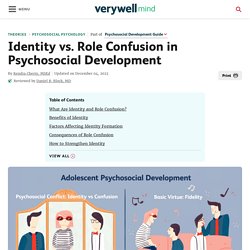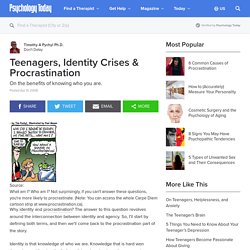

Identity vs. Role Confusion in Erikson's Theory. Identity versus confusion is the fifth stage of ego according to psychologist Erik Erikson's theory of psychosocial development.

This stage occurs during adolescence between the ages of approximately 12 and 18. During this stage, adolescents explore their independence and develop a sense of self. According to Erikson, people progress through a series of stages as they grow and change throughout life. During each stage, people face a developmental conflict that must be resolved to successfully develop the primary virtue of that stage. He was interested in how social interaction and relationships affect development and growth. Overview. Erikson's theory of psychosocial development: Identity vs Role confusion. James Marcia's Adolescent Identity Development. Teenage Self-Identity Issues: Causes, Problems, And Common Behaviors. While there are a variety of ways that teens experience identity formation, some experiences can become very harmful to the individual.

In the sections below, we discuss the causes and more serious issues in teenage identity issues & development and how parents can help. Common Causes Contributing to Unhealthy Teen Identity Development The importance of identity development for teens is huge. When a teen is developing their identity they are learning what makes them unique while also feeling the need to fit in. For teens who feel excluded from others due to their cultural, ethnic, gender, or sexual identity, this process can lead teens to begin participating in harmful behavior. Other factors that prevent the formation of a secure and positive self-identity include: Teenage self-identity issues. How Cultural Differences Influence Adolescent Development.
The parents of adolescents have the main responsibility of teaching children ethics.

Scholars of adolescent behavior and authors of "Family and Peer Influences on Adolescent Behavior and Risk-Taking," Nancy Gonzales and Kenneth Dodge, note that while much of adolescent development happens outside the home, the culture of the family instills upon children their developmental roots. Parents coming from difference cultures emphasize different value sets and therefore teach their children different moral standards. For example, because honesty is an important concept in the West, American parents urge their children not to lie, even in situations where lying would be beneficial. On the contrary, parents from East Asia tend to focus on creating a sense of both social and family harmony. These parents are more willing to overlook lies, provided those lies contribute to harmony, such as in white lies that avoid hurting others' feelings. How cultural differences influence adolescent development. HuffPost is now a part of Verizon Media. A number of years ago I overheard my then teenage son discussing with his friends the origin of AIDS.

They were not discussing how AIDS developed — arguing whether it was some errant African virus or something else such as then current conspiracy theories like germ warfare gone awry or a covered up artifact of vaccination. Rather they were arguing why — a much deeper spiritual question. Was this disease a simple development of nature, a cosmic punishment, a divine opportunity for compassion or even a Malthusian form of population control?
The conversation surprised me. I was confounded by the intensity of the debate — an intensity previously reserved for questions such as who would likely win the Super Bowl or the World Series. Throughout adolescence, the adolescent struggles with three core issues: independence, intimacy and identity. Moreover, as adolescents begin to develop critical thinking, they are encountering their own spiritual questions. Kenneth J. Adolescence, Identity and Spirituality. Self Identity in Teens: Social Media Is Getting in the Way. The shaping of self identity in teens is one of the most important and most vulnerable processes of our lives.

The self identity that we build during the adolescent years follows us into adulthood, which makes it an extremely critical period of time. Social media could be negatively affecting it, though. We live in a world where nearly every teenager has access to social media, whether it’s through their own device, a friend’s, or a shared one at home. This level of connectivity has opened many doors in the way of communication, but it has also brought about questions of the negative impact it can have on forming minds. Social media can negatively impact young girls Social media is largely based on looks. While social media is an inspirational and revolutionary means of connecting with others, focusing on appearances is never good for a girl’s mental health–and that’s exactly what social media tends to focus on and “reward” with likes.
Solstice is here for your daughter. "Social media is getting in the way" Teenagers, Identity Crises & Procrastination. Source: article continues after advertisementWhat am I?

Who am I? Not surprisingly, if you can't answer these questions, you're more likely to procrastinate. (Note: You can access the whole Carpe Diem cartoon strip at www.procrastination.ca). Article: Teenagers, Identity crises & Procrastination.